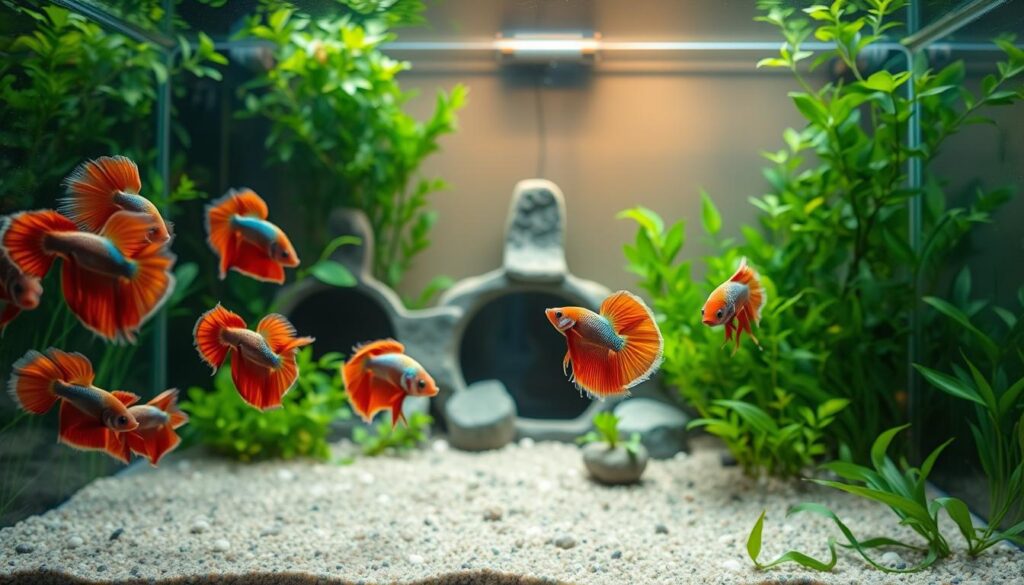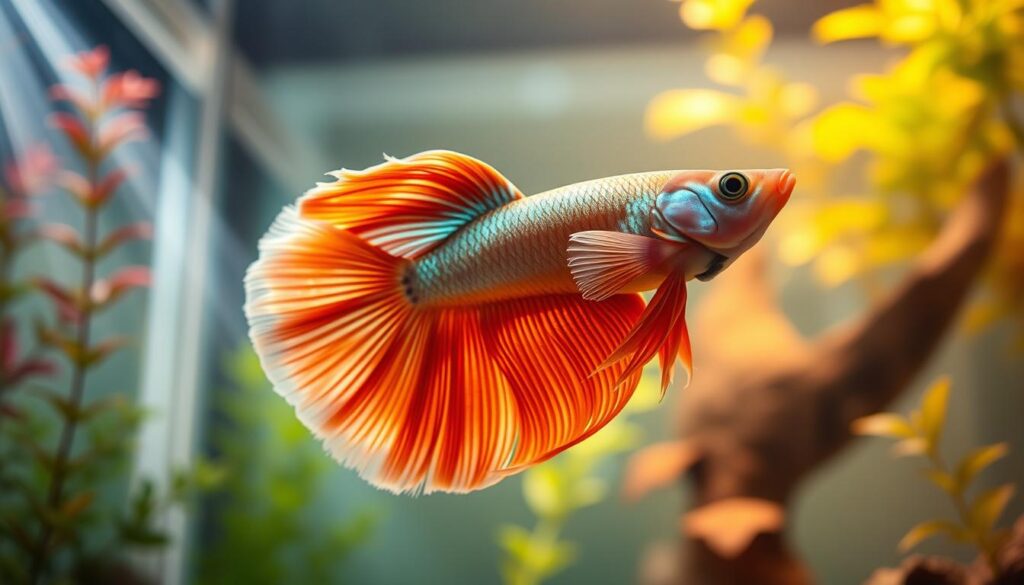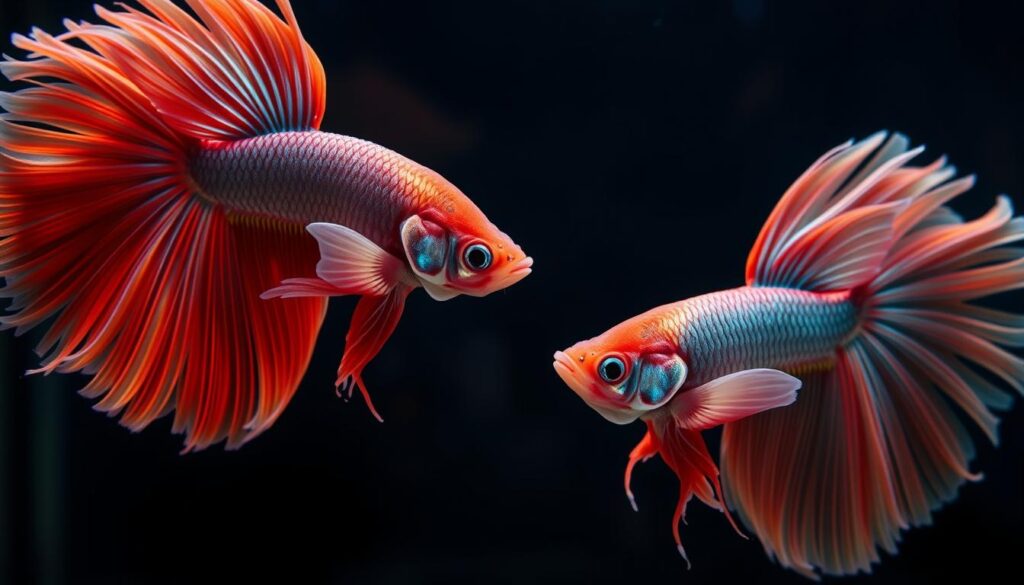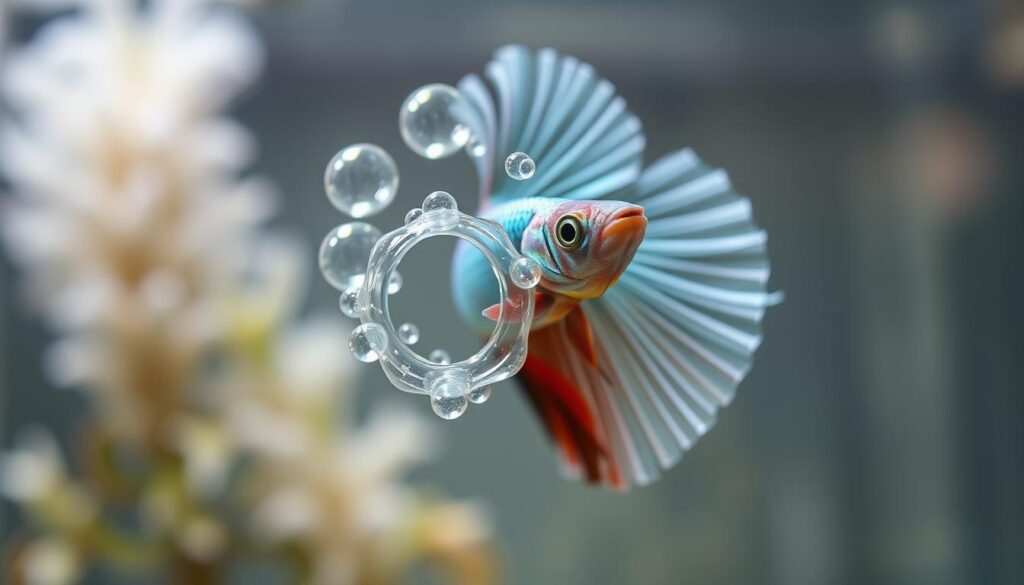Did you know that female betta fish don’t actually get “pregnant” like mammals do? Instead, they become gravid, carrying eggs until they’re ready to be laid and fertilized! This unique reproductive process is both fascinating and crucial to understand for successful breeding.
As we dive into the world of betta fish pregnancy, you’ll discover the essential tips and tricks for supporting your female betta through this critical period. Are you ready to learn the secrets of a healthy “pregnant” betta fish?
Key Takeaways
- Understand the difference between being “pregnant” and “gravid” in betta fish.
- Learn how to identify the signs of a betta fish pregnancy.
- Discover the optimal care and conditions for a healthy betta fish reproduction process.
- Get tips on how to support your female betta through the breeding process.
- Find out how to create a safe and nurturing environment for your betta fish.
Read also Samurai Betta Fish: Stunning Colors, Care Guide & Unique Traits
Understanding Betta Fish Reproduction
Betta fish reproduction involves an intricate dance between male and female betta fish, and we’re here to break it down for you! As we dive into the world of betta breeding, you’ll discover that it’s not as simple as just having a “pregnant” betta fish. In fact, betta fish don’t get pregnant like mammals do; instead, they lay eggs that are fertilized externally.
The Truth About “Pregnant” Betta Fish
When we say “pregnant betta fish,” we’re actually referring to a female betta that’s ready to spawn. This means she’s carrying eggs in her ovaries, waiting for the right moment to release them. It’s a common misconception that betta fish become pregnant like humans; instead, the female betta will lay eggs that are then fertilized by the male.
The Natural Breeding Cycle
The breeding cycle of betta fish is a complex process that involves a delicate balance between the male and female. It begins with courtship, where the male betta builds a bubble nest to attract the female. Once the female is ready, she’ll release her eggs, and the male will fertilize them. This process is crucial for successful betta fish breeding.
Male vs. Female Roles in Reproduction
In betta fish reproduction, both males and females play critical roles. The male betta builds a bubble nest to house the eggs and guards them until they hatch. The female betta, on the other hand, releases the eggs and must be removed from the breeding tank after spawning to prevent her from eating the eggs or getting injured by the male. Understanding these roles is key to successful betta fish breeding techniques.
By grasping the basics of betta fish reproduction, you’ll be better equipped to create a thriving breeding program. Whether you’re a seasoned aquarist or just starting out, understanding the intricacies of betta breeding will help you raise healthy, vibrant betta fish.
Signs of a Pregnant Betta Fish
So, you’re wondering if your betta fish is expecting? Let’s dive into the telltale signs of a gravid betta! A pregnant betta fish, or a gravid female, exhibits specific physical and behavioral changes that signal her readiness to spawn.
Physical Changes in Gravid Females
A gravid betta fish may display visible changes such as a more prominent ovipositor, which is the egg-laying tube. You might also notice white vertical stripes on her body, indicating her readiness to spawn. Additionally, her belly may appear more rounded due to the developing eggs.
Behavioral Indicators of Readiness to Spawn
Behavioral changes are just as important as physical signs! A gravid betta may start to exhibit behaviors like digging or flaring at the male betta, signaling her readiness to spawn. She may also become more active and restless, swimming back and forth in her tank.
Distinguishing Pregnancy from Bloating or Disease
It’s crucial to distinguish between pregnancy and potential health issues. Bloating can be a sign of disease or poor water quality, not just pregnancy. If your betta’s belly is swollen, but you don’t see the other signs like a prominent ovipositor or white vertical stripes, it might be a health issue rather than pregnancy. Always check your tank’s water parameters and ensure your betta is receiving proper care!
By recognizing these signs, you’ll be well on your way to successfully breeding your betta fish. Remember, a healthy and happy betta is key to a successful breeding program!
Setting Up the Perfect Breeding Tank
Let’s dive into the world of betta fish breeding by setting up the ideal tank environment for your finned friends! Creating a suitable breeding tank requires attention to detail and a understanding of what betta fish need to thrive.
Tank Size and Configuration Requirements
When it comes to breeding betta fish, tank size matters! A minimum tank size of 10 gallons is recommended, as it provides a stable environment and gives you more flexibility with equipment and decorations. The tank should be configured to accommodate both the male and female betta fish, with plenty of hiding spots and visual barriers to reduce aggression.

Essential Equipment for Successful Breeding
To create a thriving breeding environment, you’ll need some essential equipment. This includes a high-quality heater to maintain a stable temperature, a gentle filtration system to keep the water clean, and a thermometer to monitor the temperature. “A good breeder once told me, ‘The key to successful breeding is in the details – and temperature control is one of those crucial details!'”
Water Parameters and Temperature Control
Betta fish are tropical, so they thrive in warm water. The ideal temperature range for breeding betta fish is between 78°F to 82°F (25°C to 28°C). Regular water changes and monitoring of water parameters are crucial to maintaining a healthy environment. As Dr. Erik Johnson, a renowned aquarist, notes, “Stable water conditions are vital for the health and well-being of betta fish, especially during breeding.
Read Also Betta Fish Food – The Ultimate Guide for Healthy and Vibrant Bettas
Creating Hiding Spots and Bubble Nest Anchors
Betta fish, especially the male, need places to hide and feel secure. Adding plants, rocks, and other decorations can provide these hiding spots. For the male betta, creating a bubble nest is a crucial part of the breeding process. You can encourage this by providing bubble nest anchors or floating plants. As the experts say, “A well-designed tank is not just about looks – it’s about creating a functional environment that supports the natural behaviors of your betta fish.”
By following these guidelines and paying attention to the details, you’ll be well on your way to creating the perfect breeding tank for your betta fish. Happy breeding!
Nutrition for Pregnant Betta Fish
What you feed your ‘pregnant’ betta can make all the difference in the health of her eggs and the success of the spawning process! A well-nourished betta fish is more likely to produce healthy eggs and recover well after spawning.

High-Protein Diet Requirements
A gravid betta fish requires a diet rich in protein to support her reproductive health. High-protein foods are essential for the development of healthy eggs.
You can provide your betta with a variety of high-protein foods, including live or frozen brine shrimp, bloodworms, and commercial betta pellets rich in protein.
Live Foods vs. Commercial Options
Both live and commercial foods have their advantages. Live foods like brine shrimp and daphnia provide excellent nutrition and stimulate the betta’s natural hunting behavior.
Commercial betta foods, on the other hand, offer a convenient and nutritionally balanced diet. Look for high-quality commercial foods that are rich in protein and nutrients.
Feeding Schedule During Egg Development
During the egg development stage, it’s crucial to maintain a consistent feeding schedule. Feed your betta 2-3 times a day, only as much as she can consume within a few minutes.
Overfeeding can lead to digestive issues and water quality problems, so it’s essential to strike the right balance.
Supplements for Optimal Reproductive Health
While a balanced diet should provide most of the necessary nutrients, certain supplements can support your betta’s reproductive health.
For example, adding a small amount of garlic or other immune-boosting supplements to her food can help keep her healthy during this critical period.
The Breeding Process: From Courtship to Spawning
When it comes to breeding betta fish, the key to success lies in understanding their courtship and spawning behaviors. Breeding betta fish is a multi-step process that requires careful planning, patience, and attention to detail. As we guide you through this process, you’ll learn how to introduce the breeding pair safely, recognize courtship behaviors, and manage the spawning process.
Introducing the Breeding Pair Safely
Introducing the male and female betta fish to each other is a critical step. You should do this in a controlled environment where both fish can see each other but are initially separated. This visual introduction allows them to become familiar with each other’s presence without the risk of immediate aggression. Use a divider or a separate container within the breeding tank to achieve this.
Courtship Behaviors and Displays
Once the pair is introduced, you’ll observe fascinating courtship behaviors! The male betta will typically build a bubble nest, signaling his readiness to spawn. He’ll also display vibrant colors and perform a dance-like behavior to attract the female. Watch for these signs to ensure that your betta fish are ready to spawn.

The Spawning Embrace and Egg Release
The spawning act is a delicate moment. The male betta will wrap himself around the female, and she’ll release her eggs. The male will then fertilize the eggs and carefully collect them in his mouth, placing them in the bubble nest. This process can be repeated several times until the female has released all her eggs.
Post-Spawning Separation Techniques
After spawning, it’s crucial to separate the male and female betta fish. The female should be removed first, as the male can become aggressive towards her after spawning. Later, once the eggs have hatched and the male is no longer caring for the fry, he should also be removed to prevent him from eating the fry.
| Breeding Stage | Action Required | Timeline |
|---|---|---|
| Introduction | Visual introduction through divider | Day 1 |
| Courtship | Observe and ensure compatibility | Day 1-2 |
| Spawning | Allow spawning to occur | Day 2-3 |
| Post-Spawning | Remove female, then male after fry hatch | Day 3 and after |
By following these steps and understanding the behaviors associated with betta fish breeding, you’ll be well on your way to successfully breeding these magnificent creatures.
Male Betta’s Role in Egg Care
When it comes to betta fish breeding, the male betta plays a starring role in caring for the eggs! But what makes him so special?
Bubble Nest Construction and Maintenance
The male betta’s first task is to build a bubble nest, a safe haven for the eggs. He creates this nest by blowing bubbles and anchoring them with his fins! It’s a labor of love, and he takes great care to maintain it throughout the breeding process.

Paternal Care Behaviors
The male betta is a devoted parent, ensuring the eggs receive the care they need. He guards them from predators, keeps them clean, and even makes sure they’re getting enough oxygen! It’s a tough job, but he’s up for the challenge.
When and How to Remove the Male
While the male betta is a great caregiver, there comes a time when it’s necessary to remove him from the breeding tank. This is usually after the eggs have hatched, as the male can become aggressive towards the fry. You can separate him by carefully netting him and transferring him to a separate tank.
Read Also Best Betta Fish Pellets: What to Feed & How to Choose the Right Ones
Artificial Egg Care Methods
In some cases, you might need to take over egg care duties from the male betta. This can involve using a separate container to house the eggs, providing gentle aeration, and maintaining optimal water conditions. It’s a delicate process, but with the right techniques, you can successfully raise healthy betta fry!
By understanding the male betta’s role in egg care and knowing when to intervene, you can improve your betta fish breeding techniques and give your betta fish fry the best possible start in life!
Caring for Female Bettas After Spawning
Post-spawning care is a critical phase in your female betta’s life cycle – let’s dive into the details! After the eggs are laid, the female betta needs special attention to recover from the spawning process.
Recovery Period and Special Care
After spawning, it’s essential to separate the female betta from the male to prevent further stress and injury. Provide her with a quiet, comfortable space in a well-oxygenated tank with plenty of hiding spots. Monitor water parameters closely to ensure they remain optimal for your betta’s health.
Treating Injuries from Aggressive Males
Unfortunately, males can sometimes be aggressive during spawning, injuring the female. If you notice any signs of injury, such as torn fins or scales, treat the water with a stress coat or a similar product to help heal the damage. Keep a close eye on her condition and be prepared to provide additional care if necessary.
Nutritional Support for Recovery
A nutritious diet is vital for your female betta’s recovery. Offer her high-protein foods like live or frozen brine shrimp, bloodworms, or daphnia. A varied diet will help her regain strength and prepare for future breeding cycles.
Preparing for Future Breeding Cycles
To keep your female betta healthy and ready for future breeding, maintain a consistent feeding schedule, monitor her health closely, and ensure her tank environment remains optimal. Regularly check for any signs of stress or disease, and take action promptly if you notice any issues.
| Care Aspect | Pre-Spawning | Post-Spawning |
|---|---|---|
| Nutrition | High-protein diet to support egg development | Continue high-protein diet for recovery |
| Environment | Optimal water parameters and temperature | Maintain optimal conditions, add hiding spots |
| Health Monitoring | Watch for signs of stress or disease | Monitor for injuries, stress, and disease |
By following these care tips, you’ll be able to support your female betta through the post-spawning period and ensure she’s ready for future breeding cycles. Happy breeding!
Betta Fish Fry Development and Care
As your betta fish eggs hatch, you’ll enter a new world of responsibility, ensuring the fry grow healthy and strong. This critical period is filled with opportunities to make a positive impact on the development of your betta fish.
First 48 Hours After Hatching
The first 48 hours are crucial for the survival of your betta fish fry. During this period, they rely on their yolk sac for nutrition. It’s essential to maintain pristine water quality and a stable temperature between 78°F to 82°F (25°C to 28°C) to support their initial development.
Feeding Regimen for Growing Fry
Once the yolk sac is absorbed, usually within 2-3 days, you’ll need to start feeding your fry. Begin with infusoria or commercial fry food, gradually introducing brine shrimp as they grow. A varied diet is key to ensuring they receive all necessary nutrients.
Here’s a sample feeding schedule:
- Day 2-3: Infusoria or commercial fry food
- Day 4-7: Brine shrimp nauplii
- Day 7 and beyond: Gradually introduce larger foods like daphnia and finely chopped mosquito larvae
Water Quality Management for Fry Tanks
Maintaining optimal water quality is vital for the health of your betta fish fry. Regular water changes (about 10-20% daily) and monitoring water parameters will help prevent disease and promote healthy growth.
| Water Parameter | Ideal Range |
|---|---|
| pH | 6.5-7.5 |
| Ammonia | 0 ppm |
| Nitrite | 0 ppm |
| Nitrate | < 20 ppm |
Growth Stages and Development Milestones
Betta fish fry develop rapidly. By the end of the first week, they should be free-swimming and actively feeding. By week 2-3, they’ll start to display their colors, and by week 4-6, they’ll begin to show signs of finnage and adult characteristics.
As noted by betta breeding expert,
“The key to successful betta breeding lies in the details of fry care. Providing the right nutrition and environment during the early stages sets the foundation for healthy, vibrant adults.”
Culling and Selective Breeding Considerations
As your fry grow, you’ll need to consider culling to maintain the quality of your breeding stock. Look for characteristics like vibrant color, strong finnage, and robust health when selecting fish for future breeding programs.
By carefully managing the development and care of your betta fish fry, you’ll be rewarded with a thriving population of healthy, beautiful betta fish.
Common Problems with Pregnant Betta Fish and Solutions
As you embark on breeding betta fish, you may encounter several common problems. Understanding these issues and their solutions is crucial for a successful breeding program. Let’s dive into some of the most common challenges you might face!
Egg-Bound Females: Symptoms and Treatment
An egg-bound female betta is a serious condition where the female is unable to release her eggs. Symptoms include a swollen abdomen and lethargy. To treat this, you can try gently rolling the female betta in your hand (with proper care to avoid injury) or using a soft-bristled brush to stimulate the vent area. Ensuring proper water parameters and a stress-free environment can help prevent this condition.
Failed Spawning Attempts: Causes and Prevention
Failed spawning can be due to various reasons such as incompatible pairs, poor water quality, or inadequate tank setup. To prevent this, ensure that you have a compatible male and female betta, maintain optimal water conditions, and provide a suitable breeding tank with plenty of hiding spots and a bubble nest anchor. Regular water changes and a nutritious diet can also enhance spawning success.
Egg Fungus and Infertility Issues
Egg fungus is a common issue in betta breeding, often resulting from poor water quality or bacterial infections. To combat this, maintain pristine water conditions and consider using a fungicide specifically designed for aquarium use. Infertility can be caused by genetic issues, stress, or poor nutrition. Ensuring a balanced diet and reducing stress can help mitigate these problems.
Fry Mortality: Causes and Prevention
High fry mortality can be due to factors like inadequate nutrition, poor water quality, or disease. To prevent this, provide the fry with appropriate food such as infusoria or commercial fry food, maintain excellent water quality through regular changes, and monitor for signs of disease. A well-maintained breeding tank and proper care can significantly reduce fry mortality.
By understanding and addressing these common problems, you can significantly improve the success of your betta breeding program. Remember, proper care and attention to detail are key to raising healthy betta fish!
Conclusion: Creating a Successful Betta Breeding Program
Breeding betta fish can be a rewarding experience, and with the right techniques, you can achieve success. By understanding betta fish reproduction, setting up the perfect breeding tank, and providing proper care and nutrition, you’ll be well on your way to creating a thriving betta breeding program.
To start, focus on betta fish breeding techniques that work for you. This includes selecting healthy breeding stock, maintaining optimal water parameters, and ensuring a balanced diet. With breeding betta fish, patience and attention to detail are key.
As you continue your betta breeding journey, remember to stay informed about the latest betta fish care tips. This will help you overcome common challenges and improve your breeding results. By combining knowledge with experience, you’ll be able to refine your betta fish breeding techniques and achieve the results you want.
So, are you ready to take your betta breeding to the next level? With dedication and the right guidance, you can create a successful betta breeding program that brings joy and fulfillment to your hobby.

